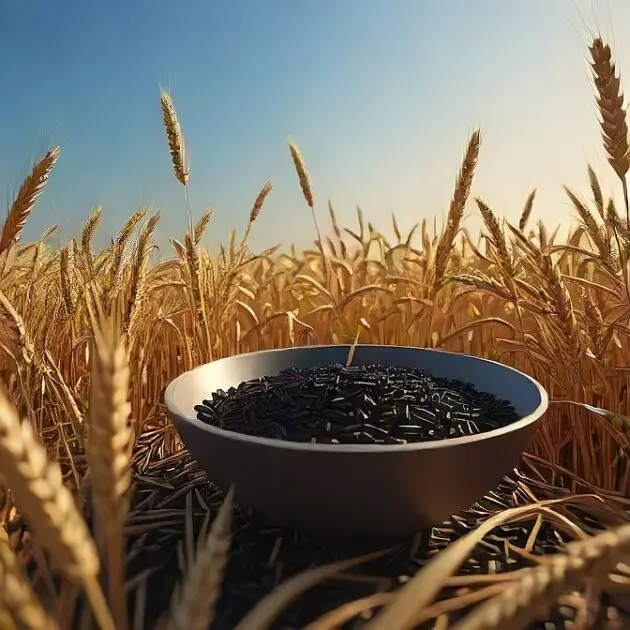Introduction
Kalanamak rice, often referred to as the “black salt rice,” is a traditional variety of aromatic rice cultivated primarily in the Terai region of Uttar Pradesh, India. Known for its distinctive aroma, slender grains, and rich heritage, Kalanamak rice has earned a Geographical Indication (GI) tag, highlighting its unique identity and cultural significance. This blog delves deep into the history, cultivation, benefits, and future prospects of Kalanamak rice, also known as kala namak paddy.
Historical Significance
Kalanamak rice holds a prominent place in India’s agricultural history. Its origins trace back over 2,000 years, with references in ancient Buddhist texts. Legend has it that Lord Buddha, after his enlightenment, gifted Kalanamak rice seeds to the people of the Shravasti region, advising them to cultivate it for prosperity. This heritage grain has since been a symbol of cultural pride and agricultural excellence.

Unique Characteristics of Kalanamak Rice
- Aromatic Excellence: The rice is renowned for its strong, natural aroma, often compared to the fragrance of freshly popped popcorn.
- Grain Quality: It features slender, medium-sized grains with a slightly black husk, hence the name kala namak.
- Nutritional Value: Rich in antioxidants, iron, and other essential nutrients, making it a healthier choice compared to many modern rice varieties.
Cultivation Process
Climate and Soil Requirements
Kalanamak rice thrives in the fertile plains of Eastern Uttar Pradesh, where the climate and soil conditions are ideal for its growth. The paddy fields require a specific temperature range, moderate rainfall, and loamy soil rich in organic matter. buy now
Sowing and Harvesting
Farmers use traditional methods to cultivate kala namak paddy. The seeds are sown during the monsoon season, and the crop requires about 140-150 days to mature. Harvesting usually takes place between November and December.
The GI Tag and Its Importance
The Geographical Indication (GI) tag granted to Kalanamak rice underscores its unique identity linked to a specific region. This tag not only protects the rice from imitation but also enhances its market value, promoting sustainable agricultural practices among local farmers.
Health Benefits of Kalanamak Rice
- Rich in Antioxidants: Helps combat oxidative stress and reduces the risk of chronic diseases.
- High Iron Content: Beneficial for individuals with anemia and iron deficiencies.
- Low Glycemic Index: Suitable for diabetics as it helps regulate blood sugar levels.
- Digestive Health: The high fiber content aids in digestion and promotes gut health.
Culinary Uses
Kalanamak chawal is a favorite in traditional Indian cuisine. Its unique aroma and flavor make it ideal for:
- Biryani and Pulao
- Kheer (rice pudding)
- Steamed rice served with curries
Challenges in Kalanamak Rice Cultivation
Despite its heritage status, farmers face several challenges:
- Low Yield: Compared to hybrid varieties, Kalanamak rice has a lower yield.
- Pest Susceptibility: Vulnerable to pests and diseases, requiring careful management.
- Market Accessibility: Limited awareness among consumers restricts its market potential.
Sustainable Practices and Modern Innovations
Efforts are underway to improve the yield and resilience of kalanamak paddy seeds through organic farming and sustainable agricultural techniques. Government initiatives and agricultural research are also supporting farmers to adopt modern practices while preserving traditional methods.

Economic Impact and Farmer Empowerment
The cultivation of Kalanamak rice has significantly contributed to the economic upliftment of farmers in Uttar Pradesh. The GI tag has opened new markets, both domestically and internationally, providing better income opportunities for local communities.
Future Prospects
With increasing global demand for organic and heritage grains, Kalanamak rice has a promising future. Strategies to enhance production, improve marketing, and create awareness can help this ancient grain gain the recognition it deserves.
Easy To Buy
Kalanamak rice, often referred to as the “prince of rice,” is an ancient variety of scented rice known for its unique aroma, slender grains, and rich taste. It has been cultivated for centuries, primarily in the Terai region of Uttar Pradesh, India. Despite its heritage and exceptional quality, buying Kalanamak rice has become increasingly easy due to its growing popularity and the expansion of online and offline markets.
You can find Kalanamak rice in local grocery stores, especially in regions where traditional or organic products are in demand. Many supermarkets now stock it in their specialty or organic food sections. Additionally, visiting farmers’ markets or agricultural fairs in areas known for rice cultivation can give you access to freshly harvested Kalanamak rice directly from the growers.
The easiest and most convenient way to purchase Kalanamak rice is through online platforms. E-commerce websites like Amazon, Flipkart, and diviam aahar specialty organic food sites offer a wide range of Kalanamak rice brands. These platforms provide detailed product descriptions, customer reviews, and options to compare prices and quality. Moreover, many government-supported portals and farmer cooperatives also sell Kalanamak rice online, ensuring authenticity and fair pricing.
In conclusion, whether through local stores, direct from farmers, or online platforms, buying Kalanamak rice is now more accessible than ever.
Conclusion
Kalanamak rice is more than just a grain; it is a testament to India’s rich agricultural heritage and cultural diversity. As we move towards sustainable food practices, embracing such heritage grains can lead to healthier diets and empowered farming communities. The legacy of Kalanamak rice continues to thrive, bridging the past with the future of agriculture in India.
External Link

 Best Kalanamak Rice in India: A Heritage Grain with Unmatched Aroma
Best Kalanamak Rice in India: A Heritage Grain with Unmatched Aroma